Rebecca (Rywka) Polacz
1. Introduction
We are students of the second grade of the 5th Secondary School in Włocławek. We were interested in the “Convoi 77” project by Ms Katarzyna Dąbrowska, our Polish teacher and deputy headmaster of the school, who has had many projects devoted to memory, multiculturalism and the Holocaust. Despite the pandemic, we did not give up our search, deciding to finish the work that we had begun. It was not easy, the more so that we were commissioned to develop a biography of Mrs. Rebecca from Konin, a town situated about 100 km from Włocławek, our place of residence. Therefore, the vast majority of the work was performed remotely, we were divided into research teams. We analysed all the documents and information. Below we present the results of our work.
2. The birth and lineage of Rebecca (Rywka) Polacz
Rebecca Polacz was born on July 2, 1880 as Rywka (Ryfka) Gryn, subject to the Russian Tsar. (The documents contain a different spelling of the ancestral name – we will consistently use the form of Rywka later in the biography). Rebecca Polacz (Rywka Gryn) came from a Jewish family living in Konin in the then Russian partition. It should be remembered that in the nineteenth century, Poland was not on the map of Europe, because from 1795, there has been three territorial divisions or partitions of the country.
There are no documents on the basis of which we could determine the exact address of her residence, but thanks to the courtesy of the District Museum in Konin, we received photos of the city from the turn of the 19th and 20th centuries. Some of them – with the consent of the aforementioned institution – have been included in our work.
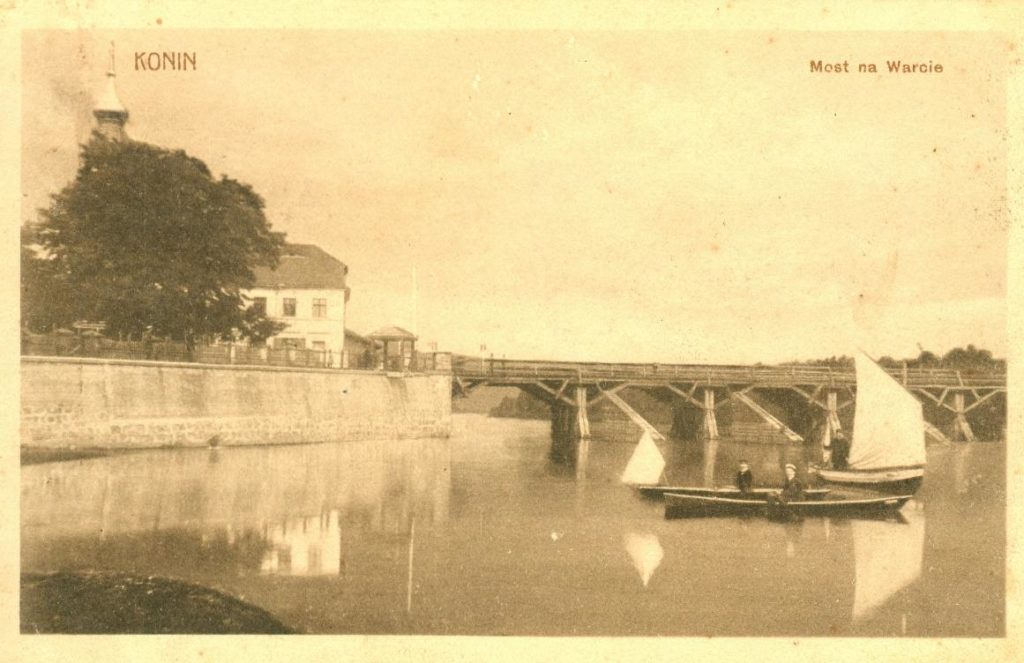

Photographs from the collection of the Konin Museum, showing a view of the bridge over Warta River and one of Konin streets.
The parents of Rebecca Polacz (Rywka Gryn) were Dawid Gryn and Frymeta born Stockholm. Apart from Rebecca (Rywka), the Gryn family had two daughters, Malka and Laja. Two documents relating to them have survived. The first confirms the birth of Laja. The second documents the marriage between Malka and Natela Sztajner.


Laja’s birth and marriage certificates from the collections of the State Archives in Poznań
(number 840 – signature 76/1882 i 28/1899).
Based on the information found in the archives (www.jripoland.org), we have created the family tree of Rebecca Polacz (Rywka Gryn), as shown below.
Genealogical Tree of Rywka Gryn
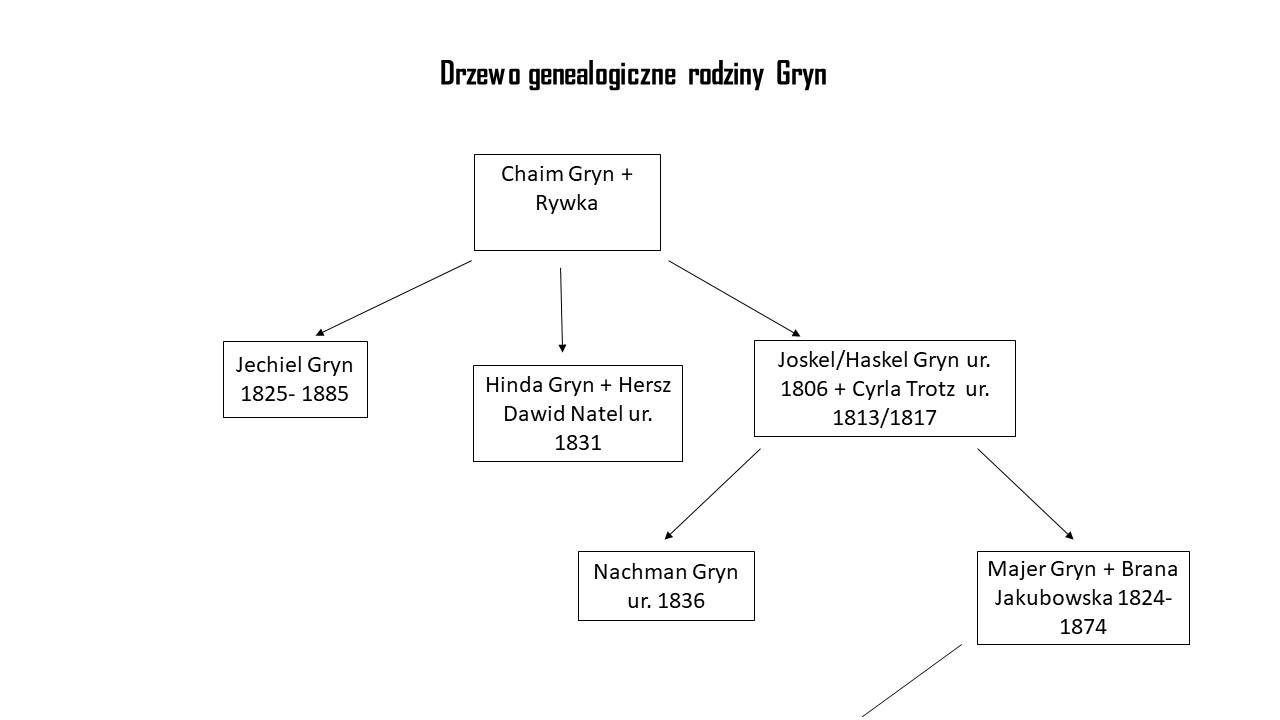
3. The marriage of Rebecca Polacz (Rywka Gryn) and the origin of her husband
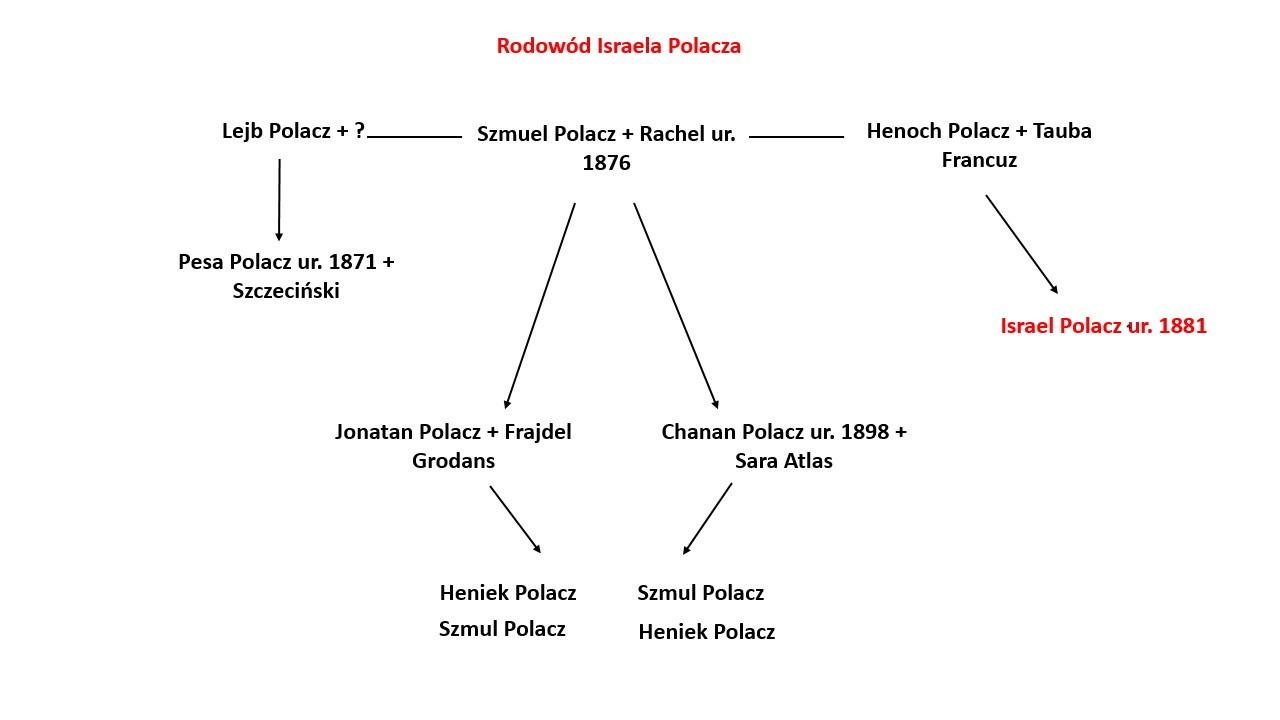 The marriage was concluded on March 29, 1910. Rebecka (Rywka) and Israel were married by Jakub Lipszyc (Jacob Liebschütz) in a synagogue in Konin. It is worth adding that he was the last of the four local rabbis. He came from Lithuania, and he served as a rabbi in Konin from 1906 until his tragic death at the hands of the Nazis in 1942. We found his photo in the book by T. Richmond, „Persistent echo”. (Uporczywe echo.) Sztetl Konin.
The marriage was concluded on March 29, 1910. Rebecka (Rywka) and Israel were married by Jakub Lipszyc (Jacob Liebschütz) in a synagogue in Konin. It is worth adding that he was the last of the four local rabbis. He came from Lithuania, and he served as a rabbi in Konin from 1906 until his tragic death at the hands of the Nazis in 1942. We found his photo in the book by T. Richmond, „Persistent echo”. (Uporczywe echo.) Sztetl Konin.

Photograph of Jakub Lipszyc from T. Richmond book „Persistent echo”( ,,Uporczywe echo”.) Sztetl Konin.
The day after the wedding of Rebecca (Rywka) and Israel, the rabbi went to the town hall in Konin to inform about their marriage.

Photograph of the Konin town hall from the collection of the District Museum in Konin.
The wedding certificate prepared for this occasion provided us with some interesting information. The witnesses at the wedding were 60 year old Lejba Beatus and 46 year old Helman Szmul. The celebration istelf was preceded by announcements in the Konin synagogue and in the synagogue of Tursk, where Israel Polacz lived. The bride and groom did not conclude a prenuptial agreement.

Marriage certificate of Rywka Gryn and Israel Polacz from the National Archives in Konin
(number 840 – signature 42/1910).
We imagine that the wedding ceremony was in line with the Jewish custom of the time: the marriage was concluded under a special canopy called a chupa, Rebecca (Rywka) circled seven times her chosen spouse, he crushed the glass with his heel in memory of the destruction of the Temple of Jerusalem, also expressing this way, the desire to return to the Promised Land, and then all gathered, expressed joy and good luck, crying out Mazel tov.
4. The birth of Rebecca’s (Rywka) Polacz children
A year after the wedding, Rebecca (Rywka) Polacz gave birth to a son, Hanan. The boy was born in Konin on 11 March 1911, and eight days later, in keeping with the Judaic tradition, he was circumcised. The birth of the boy was reported in the Konin town hall by his father, who appeared with the newborn in his arms, in the company of the same witnesses who confirmed the marriage of Rebecca (Rywka) and Israel one year earlier. It appears from the entry in Hanan’s birth certificate that Mr. Israel Polacz supported the family as a trader. Based on this, we believe that Rebecca (Rywka) Polacz did not work and that she was taking care of the house.

Birth certificate of Hanan Polacz from the National Archives in Poznań (number 840 – signature 9/1911).
Three years later Rebecca (Rywka) gave birth to her daughter Frymeta. The child was born in Konin in February 1914.

Information mentioning the birth of Frymeta Polacz in 1914 in Konin in one of the documents from the Convoi 77 Association in France.
5. The life of the Jewish community in Konin at the time of Rebecca (Rywka)
We did not know much about the life of Konin Jews at the turn of the 19th and 20th centuries and the everyday life of the Polacz family. That’s why we decided to add various information on this subject. For this purpose, we have searched the school library and got acquainted with the book by Theo Richmond pt.;Uporczywe echo “Persistent echo”. Sztetl Konin. We searched , and also retraced news about Konin on the website www.wirtulaszetl.pl and we have got knowledge in this way.
The beginnings of a Jewish settlement in Konin
The beginnings of the Konin Castle can be traced back to the early Middle Ages. A Konin settlement was created on the trade route, which was moved to another place, giving the city legal rights. Over time Konin became an important economic centre. One can date back the presence of Jews in this city to the end of the 14th century. It is probably connected to the fact that at the same period, followers of the Mosaic Religion arrived in Poland in order to escape persecutions in Western Europe. A larger group of Jews had been settled in the Greater Poland, but not everyone watched them with a favorable eye. Therefore, the Prince of Kaliski, Bolesław Pobożny, provided Jews in the 13th century with religious and economic privileges, and Kazimierz Wielki ordered to extend them to the whole territory of Poland. Since then, Jewish life had either flourished in Konin or died, depending on the fluctuations of the turbulent history of the Polish state, among others Zagrows with the Teutonic Order, Polish-Sweden Wars, the Partitions of Poland, but also the economic and social situation, or the growing anti-Judaism and anti-Semitism.
The Jewish Quarter
As we know Rebecca Polacz (Rywka Gryn) was born at the end of the 19th century. At that time, Konin Jews had their neighbourhood in the streets where they inhabited and lived their everyday life. The most famous of them was the Jewish street near the castle walls, existing from the 17th century. The street was remembered after the Second World War as Teper Mark, the potter’s market, in which Jews traded. According to T. Richmond and with the confirmation of the current State Archives in Poznań, connected to the Konin Information Office, in addition to Teper Mark existed a large market surrounded by Jewish houses, but the peasants traded on it. Perhaps Rebecca (Rywka) bought food, and her father and son offered goods on the pottery market.

The plan of Teper Mark was made by T.Richmond and published in his book, Uporczywe echo. Sztetl Konin. Poszukiwanie”.
On Saturday morning, pious Jews crossed the pottery market on their way to the synagogue, located in the vicinity of streets leading on one side to the Warta River, and on the other to the park. Built in 1829, and according to T. Richmond, the synagogue stood out with golden carvings, four columns on the corners, stained glass windows, a balustrade for the women section, walls decorated with colourful paintings and Hebrew inscriptions. There was also the Bet Midras – “House of Science”, “Search House”, “House of study” (BES-MedResz), or a special room devoted to Talmudic studies of boys and men at the synagogue.

The view of the Konin synagoge and the medresou from the virtual shtetl at the link https://sztetl.org.pl/pl/file/86030?ref=gallery&town=Konin&townID=509&.
In Konin, at the time of Rebecca (Rywka) Polacz, there were many other places of prayer – you could go to a chewra, a meeting place for a small brotherhood of members, with religious and social activities.
The Jewish community also offered its members the possibility of education. From the age of three, little Jewish boys studied in a Cheder, trying to memorize fragments of the Torah with comments. The Coeducational Jewish Gymnasium was established at the time of the independance of Poland, but probably at that time Mrs. Polacz was no longer in Konin. Her son studied in one of Konin’s cheders.
Emigration of the Jewish population
At the turn of the 19th and 20th centuries, some Jewish families began to leave Konin, choosing the path of migration or emigration. The destinations were various major cities, other European countries, America, Palestine. What contributed to such a decision?
We know from history lessons that some areas of economic life were not intended for Jews, and the privileges granted to them by the statute of Henry the Pious and confirmed by Casimir the Great did not exist any more in the 19th and 20th centuries.
Jews could trade and produce goods, which was their main source of income. At the time of Rebecca (Rywka) Polacz, the Jewish community in Konin consisted of shopkeepers. There were few wealthy merchants and entrepreneurs who owned land and real estate. So to whom, apart from the local peasants, did small Jewish producers sell their goods, including Israel Polacz?
We have mentioned that Rebecca (Rywka) Polacz was born in the Russian partition.
The 13th Kargopolian Dragons’ Regiment was stationed in Konin at that time. Soldiers and their families formed a community of about 1,000 persons. And they were the recipients of the products and services of the members of the Jewish community.
In return, they gave jobs, and thus guaranteed income not only to Jewish families. Therefore, the decision of the tsarist authorities in 1910 to transfer the dragoon regiment to another city turned out to be fateful for all the inhabitants of Konin. Many of them were left without the possibility of earning money and decided to emigrate. However, it happened that only one person left the family, because there was no money for tickets for all its members.
The beginning of the 20th century also saw a rise in the nationalist mood, and therefore an hostile attitude prevailed towards representatives of other nations, in the whole of Europe, including Tsarist Russia. The victims of this hostility were often Jews. Pogroms, boycotts of Jewish shops, unfounded accusations, betrayal and taking work from them also influenced the decision to leave Konin.
6. Departure of Rebecca (Rywka) to France
All indications seem to show that it was for economic reasons that in 1913 the husband of Rebecca (Rywka) Polacz left for France. She stayed with her little son, and the following year gave birth to a daughter in Konin, as we mentioned earlier.
The living grandson of the Polacz – Leon Gryn – thinks that the reason for leaving Konin was probably anti-Semitism, but the granddaughter, Mrs. Josiane Sasson, points to economic reasons, as her father mentioned that during his childhood he was often hungry. We also believe that the cause of Mr. Israel Polacz’s emigration was the poverty that plagued the family, especially after the Russian dragoons had left the city. The insufficient financial resources of the Polacz family are evidenced by the fact that Mr. Israel left alone, so most likely they could not afford the trip for the whole family.
We do not know when Rebecca (Rywka) Polacz joined her husband. The first documented information about their stay in France dates back to 1925. After living together in Paris, they applied several times to the French authorities for their naturalization. Mr. Polacz wrote in 1925 that he worked as a hatter, earning 200 francs a week. At that time, he lived in Paris on rue Monsieur le Prince with his unemployed wife and two children, but he had been living in France since 1913.

Mr Israel’s application to the French authorities of a request for naturalization
from the collection of the Convoi 77 Association in France.
At that time, they were refused naturalization because, according to the French authorities, Mr. Israel Polacz and his wife spoke too little French.
In 1929, Rebecca (Rywka) and Israel Polacz renewed their request of citizenship to the Authorities. Their efforts were partially crowned with success – Israel Polacz and his children were granted French citizenship in 1930 but not Rebecca.

The document confirming the possibility of granting French citizenship to Israel Polacz and his children,
from the Convoi 77 Association.
At that time, Ms. Polacz – like many other Jews from Central and Eastern Europe – gave new French names to herself and her children. And so Rywka became Rebecca, Hanan Armand, and Frymeta Françoise.
Before the outbreak of World War II, another important event took place in the life of the Polacz family. In 1937 their daughter Françoise (Frymeta) got married to Joseph Gryn, born in 1911 in Przytyk, Poland. Two years later, in May 1939, the grandson of Rebecca (Rywka) and Israel Polacz was born. The boy was named Leon.

The birth certificate of Leon Gryn from the Mémorial de la Shoah in France.
7. World War II – arrest and death of Rebecca (Rywka) Polacz
During World War II, Rebecca (Rywka) Polacz lived in Paris 4, Place du Marché Sainte Catherine, Le Marais, Paris, district inhabited by many Jews.

The photo (from Google Maps) of the building in which Ms Rebecca (Rywka) Polacz lived in Paris.
We do not know about the life of Rebecca (Riwka) and her relatives during the war. We believe that despite some restrictions, Nazi persecutions and threatening dangers, they tried to live a simple life. This is evidenced by the fact that Mr. Israel Polacz went for walks every day and for this reason he was not at home on 27 or 28th July 1944 (various dates in the documents obtained), when his wife was arrested because she was of Jewish origin. After imprisonment, Rebecca (Rywka), and other captured Jews were transported to the Drancy camp, where she was emprisonned from 28 to 31 July 1944.

Document from the Convoi 77 Association in France,
confirming Rebecca’s stay in the Drancy camp on 28-31 July 1994.
On July 31, 1944, Rebecca is in the Convoy 77 who left the Camp of Drancy for the immediate extermination center of Auschwitz. On the transport list, her name has the number 26051. The convoy reached Auschwitz on August 5, 1944. 726 from about 1310 women, men and children were immediately killed in gas chambers. Among them was Mrs. Rebecca (Rywka) Polacz, as we learn from the death certificate issued after the war by the French authorities.
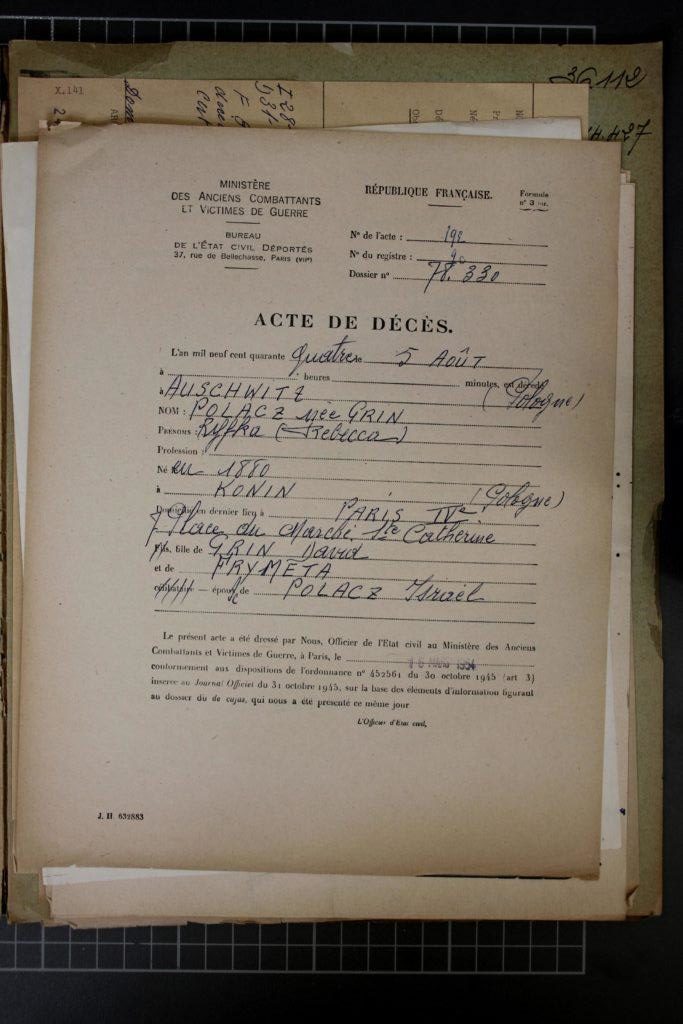
Rebecca (Rywka) Polacz’s death certificate issued by the French authorities after the Second World War (document from the Convoi 77 Association).
The death of Mrs. Rebecca (Rywka) Polacz in the camp right after her arrival is also confirmed by other documents preserved in postwar times, when Mr. Israel Polacz tried to determine the fate of his wife since her arrest. Rebecca’s death (Rywka) in Auschwitz is also mentioned in 1975, at the Yad Vashem Institute in Jerusalem by the grand-daughter of Rebecca (Rywka) – Mrs. Josiane Polacz (currently Sasson).

Document from Yad Vashem collection signed by Josiane Polacz,
mentioning the Rebecca (Rywka) Polacz’s death in Auschwitz in 1944.
8. The story of the closest family members of Rebecca (Rywka) Polacz
The husband of Rebecca (Rywka), Israel Polacz, survived the war. We know from Mrs. Josiane Sasson that he died at the age of 96, living with his daughter and her family in Paris since the end of the war.
The son of Rebecca (Rywka) Polacz, Armand (Hanan), took part in the Franco-German battles at the beginning of World War II. He was a prisonner of war. The Germans sent him to work in a farm in the country in France from where he managed to escape. He settled down in Lyon and there in 1943 he married Germaine, born in Alsace. They had a daughter, Josiane, born in 1946, who grew up in France. After graduating from translation studies at the age of 26, she left for Israel. As she told us in her letter, her father, Armand (Hanan) Polacz, made women’s hats before the war, and when they ceased to be fashionable, he found employment at his brother-in-law, Joseph Gryn’s clothing workshop in Paris. Josiane, residing in Jerusalem, married Avraham Sasson and gave birth to three children: Ouriel, Keren and Itamar .She also has two grandsons Nadav and Tal. Her husband died on 24th January 2021. The remaining members of the family live in Israel.
The daughter of Rebecca Polacz – Françoise (Frymeta) – survived the war, as did her husband Joseph Gryn and their son Leon. At that time, she was working in one of the Parisian offices. Her son Leon, as an adult, married Claudine from Egypt. They had offspring and we know their fate, but at the request of Mr. Leon, we must keep this part of knowledge for ourselves. Françoise (Frymeta) and her husband had one more child, a daughter born in 1952. These descendants of Rebecca (Rywka) Polacz live in France.

9. Commemoration of Rebecca (Rywka) Polacz
Thus, in France and Israel, there are descendants of Rebecca (Rywka) Polacz: grandchildren, great-grandchildren and great-great-grandchildren. We managed to have permanent correspondence with her grand-daughter – Ms Josiane Sasson, who lives in Israel. In each additional letter, she thanks us for the work devoted to her grandmother. She sent a photo of herself with her grandson Nadav in a good spring setting.

Unfortunately, we did not manage to obtain a photo of Ms Rebecca Polacz, because neither the family nor any institution has even one single photo.

Imaginery portait of Rebecca (Rywka) Polacz , created by Maja Pilarska, a student of the second grad of the 5th Secondary School at the Zespół Szkół Samochodowych in Włocławek.
So far, the only commemoration of Rebecca (Rywka) Polacz was an entry on the plaque of names at the Memorial de la Shoah in Paris and her name is also engraved at the Mémorial de la Déportation des Juifs de France, in Roglit, Israel, which commemorates all the Jews who have been arrested, deported in France and subsequently assassinated.

Photograph of the “Mur des Noms” in the Mémorial de la Shoah in Paris.
We are glad that the entry of Rebecca (Rywka) Polacz on the plaque of names in Paris will not be the only reminder of her name. Apart from the biography, we decided to propose other forms of commemoration. On June 1, 2021, we organized a vernissage to which we invited the local and school environment. It was a very important and moving event.




Ms Rebecca (Rywka) Polacz will also be a participant in our book, which we will create from the materials collected over the year. The article describing the entire project by the project supervisor- Ms Katarzyna Dąbrowska, will be sent to the school library and UczMy magazine, published by the Kujawsko-Pomorskie Teacher Education Center in Włocławek.
Information about our activities are also available on Edupolis- the Kujawsko-Pomorskie Educational Platform, the website of the Convoi 77 Association, the School’s website www.zss.q4.pl and in the Włocławek media:
- https://www.facebook.com/Zespol.Szkol.Samochodowych.Wloclawek/posts/4652173928144369?__tn__=K-R
- https://ddwloclawek.pl/pl/15_fotorelacje/97_szkolne/14439_wernisaz-wystawy-projekt-convoi-77-w-zss-we-wloclawku.html
- http://www.wloclawek.pl/pl/galeria/1/312/1/200
- https://q4.pl/aktualnosci/2021/05/31/wernisaz-podsumowujacy-projekt-convoi-77
- https://q4.pl/aktualnosci/2021/06/02/wernisaz-projektu-convoi-77-w-zespole-szkol-samochodowych
- https://youtu.be/d14aIb0XCNo
- http://www.kujawy.info/puls-miasta/w-samochodowce-pamietaja-o-trudnej-historii/
- http://www.wloclawek.pl/pl/artykul/76/17832/podsumowanie-realizacji-europejskiego-projektu-convoi-77-w-zespole-szkol-samochodowych-we-wloclawku
- http://wlc.pl/podsumowanie-realizacji-europejskiego-projektu-convoi-77-w-zespole-szkol-samochodowych-we-wloclawku/
- https://www.portalwloclawek.pl/wiadomosci/4936,uczniowie-samochodowki-odtwarzali-biografie-jednej-z-1310-osob-skazanych-na-zaglade-w-auschwitz-birkenau
- https://mojwloclawek.pl/20210601406459/um-wloclawek-podsumowanie-realizacji-europejskiego-projektu-convoi-77-w-zespole-szkol-samochodowych-we-wloclawku1622587385
- https://edupolis.pl/projekt-convoi-77-w-zespole-szkol-samochodowych-we-wloclawku/
- https://convoi77.org/pl/wernisaz-w-zespole-szkol-samochodowych-we-wloclawku/
- https://wloclawek.naszemiasto.pl/takie-sa-najnowsze-informacje-z-urzedu-miasta-wloclawek-4/ga/c1-8304028/zd/62400200
- http://zss.q4.pl/szablon.php?id=1488
10. Sources
When preparing the biography of Rebecca (Rywka) Polacz, we used the collections and materials from the State Archives in Poznań, the District Museum in Konin, the Polin Museum of the History of Polish Jews in Warsaw, the Jewish Historical Institute in Warsaw, the Yad Vashem Institute in Jerusalem, a book by Theo Richmond “A persistent echo. Konin Sztetl. Search ”, resources www.jri-poland.pl
11. Dedication
We dedicate our yearly work to the youngest descendants of Rebecca (Rywka) Polacz. We hope that they will never forget about their great-great-grandmother who comes from Poland. We would like them to be guided by the thought of the founder of Hasidism, the Baal Shem Tov: “Forgetfulness is exile, memory – the path to salvation.”
12. Authors of the biography
The project was implemented in the 2020/2021 school year by students of the second grade of the 5th General Secondary School at the Zespół Szkół Samochodowych im. Tadeusza Kościuszko in Włocławek, composed of: Anna Bieniecka, Roksana Brykalska, Julia Czaplińska, Martyna Gawryś, Manuel Gmurski, Martyna Kwapińska, Maja Pilarska, Wiktoria Manowska, Agata Podolska, Wiktoria Rutkowska, Julia Ryniecka, Oliwia Safian, Nikola Targańska, Oliwia Typiak, Sandra Walczak, Anastazja Zalewska, Zuzanna Zapiec.

Martyna Gawryś, Maja Pilarska, Manuel Gmurski, Wiktoria Manowska

Anna Bieniecka, Nikola Targańska, Martyna Kwapińska, Oliwia Safian
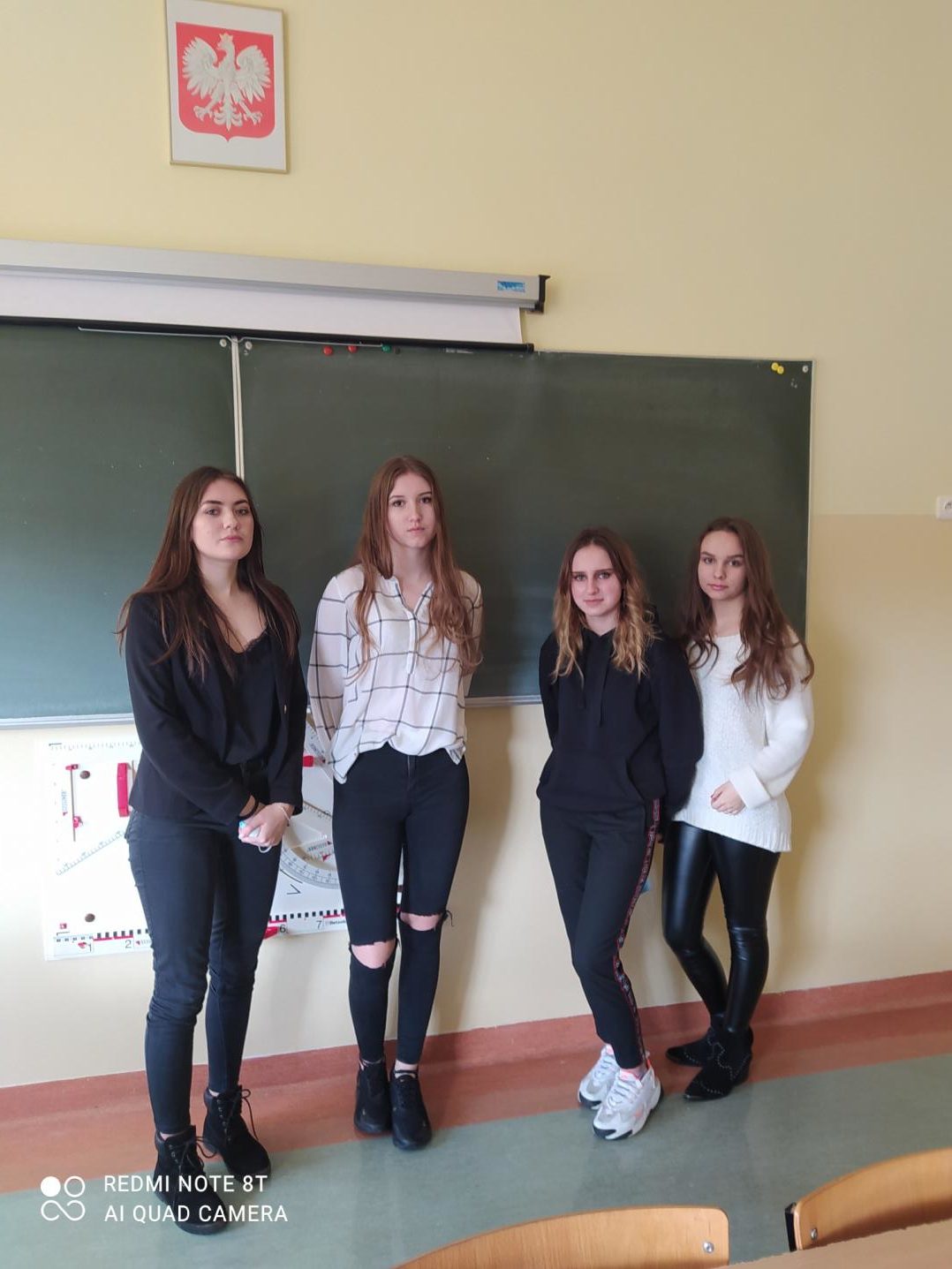
Sandra Walczak, Julia Ryniecka, Oliwia Typiak, Julia Czaplińska

Anastazja Zaleska, Zuzanna Zapiec, Roksana Brykalska, Agata Podolska, Wiktoria Rutkowska
The project supervisor was Ms Katarzyna Dąbrowska, the deputy headmaster of the school, a teacher of Polish, with whom the following teachers cooperated: Ms Magdalena Cześnin (class teacher), Ms Aniela Murzyńska (English teacher), Ms Anna Augustynowicz (Germanist), Ms Barbara Kryniska (Romanist, not related to work with our school), Ms Anita Kaniewska Kwiatkowska (historian), Mr Konrad Adamczewski (IT specialist), Ms Wioletta Klepacz (librarian), Ms Agata Kurzępa (librarian).

Wioletta Klepacz, Konrad Adamczewski, Anita Kaniewska – Kwiatkowska, Katarzyna Dubrowska, Agata Kurzępa, Aniela Murzyńska, Magdalena Cześnin, Anna Augustynowicz
13. Summary – project evaluation
After completing the project, we filled in the questionnaire, answering the questions asked by the
project education supervisor of the school. Our reflections and opinions are presented below.
-
What did you learn during the implementation of the project “Convoi 77”?
- I gained knowledge about the history and extermination of Jews, coming from the Polish language.
- I found out how the Auschwitz-Birkenau camp functioned.
- I got to know a world that I had no idea about.
- I saw what the everyday life of Polish Jews in Konin was like, their customs, culture, holidays.
- I looked at the situation of the Jews and came to the conclusion that they are worthy people.
- I understood the importance of acceptance and tolerance for other people without prejudice about their origin and what leads to unjustified hatred, racism, anti-Semitism.
- In carrying out the tasks performed, I was responsible for their implementation and work in a group, finding and analysing information, improving the organization and carrying out tasks and a responsability for my own and others’ work.
- I have improved my language and art skills.
-
What did you not know when starting the biography of Mrs. Rebecca (Rywka) Polacz from Konin? What’s new for you?
- I did not know anything about the Jewish population and their everyday life.
- I had no idea about Nazism, the war, the Holocaust and its scale, and neither the KL concentration and extermination camp Auschwitz – Birkenau.
- I could not imagine the suffering of the victim, the Jews.
- I did not know that a person like Ms Rebecca Polacz existed.
- I did not know about the transport of Jews to KL Auschwitz-Birkenau.
- I did not know that you can get involved and spend a lot of time searching information about a person’s life despite the fact that many years have passed since her death.
- I was not aware that it is possible to work on such a big project so effectively.
-
What are the advantages of the project and the way it is implemented?
- Implementation of the project throughout Europe.
- Connecting people and encouraging action.
- The opportunity to learn about the history of our heroine and the history of the Jewish community in Poland.
- A chance to meet other people from Convoi 77 thanks to biographies by peers from Europe.
- The possibility of an individual approach to the project, but also the need to work out a common position in the group.
- An opportunity to work in research teams.
- Assigning the responsibility to everyone.
- Broadening horizons, enriching knowledge, acquiring new skills, “spreading our wings”.
- Establishing correspondence in foreign languages with people from outside Poland – the grand-daughter of Ms Rebecca (Rywka) Polacz, living in Jerusalem, and through her with her family in France, and a volunteer from the Memorial de la Shoah in Paris.
- The possibility to participate at various online workshops and virtual study visits.
-
4. What would you change, improve, add to the project?
Nothing should be changed, although we regret that due to the pandemic we could only visit all the institutions and the Auschwitz-Birkenau Museum online.
-
What would you like to convey to the project initiators? Was it worth pursuing? What would you point out to their attention?
- The project was interesting, enriching, intriguing, it gave the opportunity to learn something new that we had not dealt with before.
- You could experience the past.
- The implementation of the project made it possible to learn not only the history of the death of a person from the transport to the gas chambers, but also the history of her life, which deepened our knowledge of general history, including Nazism, totalitarism, the Holocaust.
- Words of thanks, because the whole world can learn about the heroes of the project, their heroism, struggles and everyday worries.
- Thanks to the project, future generations like ours will not forget what happened to European Jews during World War II.
- In this way we can pay tribute to the murdered.
- The project is of great importance for the families of people from “Convoi 77”.
- The project should still be promoted, because still many people do not know about its existence.
- It was only thanks to the project that I learned that the happy life of ordinary people can be brutally interrupted and tragically ended because of their origin.
- Our work meant that people from “Convoi 77” are not numbers from an anonymous document, but people whose fate should not be indifferent to anyone.
- The project was important because it strongly influenced our emotions.
-
What words would you say to your peers from all over Europe working on this project? What connected you, despite the differences of country of origin, language, tradition, culture and religion?
- Despite the differences in our origins, language and religion, we were connected by the history of people from “Convoi 77” and the will to act and curiosity about the past.
- We all do something important, necessary, something that will remain for the next generations.
- Surely, we all feel proud because we made history.
- Each of us, young Europeans taking part in the project, deserves respect because if we created a biography, it means that we did not give up facing difficulties while working.
- We build memory, we help, and our actions are completely selfless.
- Let us be glad that we did not experience the war.
-
What would you like to pass on to the family of Ms Rebecca (Rywka) Polacz – her grandchildren, great-grandchildren and the youngest generation?
- We would like to offer a biography of Mrs. Rebecca (Rywka) Polacz created by us and thank you for your help in obtaining information about the fate of her son and descendants.
- Although we do not know them personally, they are close to us, just like Rebecca (Rywka) Polacz. They were like our family.
- The memory of Ms Rebecka (Rywka) Polacz will not pass away, because we recreated the biography and we wrote it down, and the protagonists of the project will stay in our hearts forever.
- We know that the descendants of Rebecca (Rywka) Polacz knew little about her, but they will thank us, so we are very happy about it.
- What we did was important to us, we feel proud of a job well done, although surely not everything has been established.
- We will always be the keepers of the memory of Mrs. Rebecka (Rywka) Polacz from Konin.


 Français
Français Polski
Polski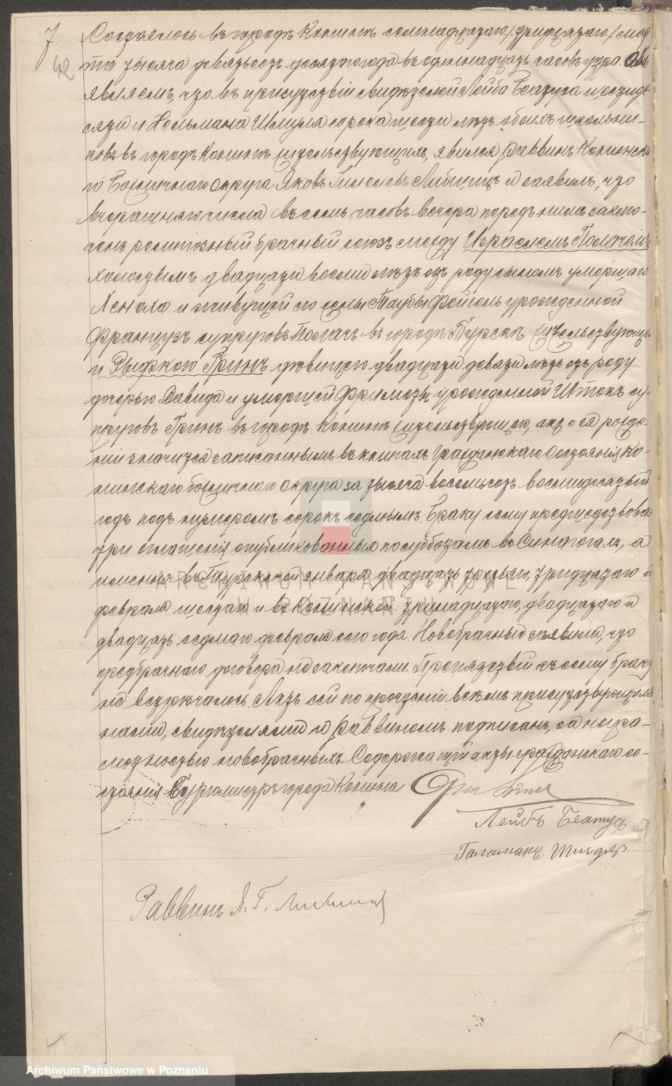










Thank you for your efforts. You created a living memorial to both an individual and a community who perished because of bigotry and violence. In doing so, you have influenced potentially thousands of people who will learn about the harm that was done and will not repeat – or let others repeat – the mistakes of the past. Bravo.